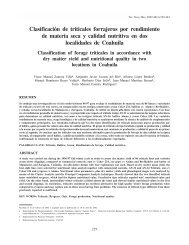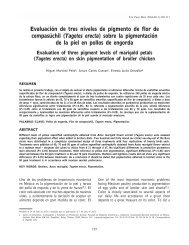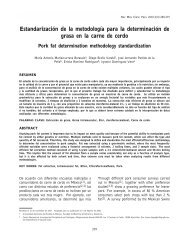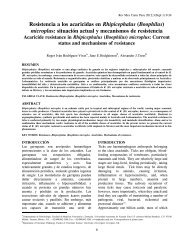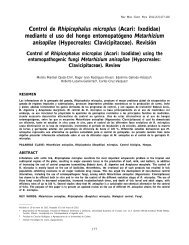Digestibilidad de nutrimentos en lechones alimentados con dietas ...
Digestibilidad de nutrimentos en lechones alimentados con dietas ...
Digestibilidad de nutrimentos en lechones alimentados con dietas ...
Create successful ePaper yourself
Turn your PDF publications into a flip-book with our unique Google optimized e-Paper software.
María <strong>de</strong> los Ängeles Aguilera Barreiro, et al. / Téc Pecu Méx 2006;44(3):301-311<br />
a las <strong>dietas</strong> <strong>de</strong> iniciación ingredi<strong>en</strong>tes digestibles<br />
para facilitar los procesos <strong>de</strong> digestión y absorción<br />
<strong>de</strong> los <strong>nutrim<strong>en</strong>tos</strong> (1) . En este s<strong>en</strong>tido las proteínas <strong>de</strong><br />
orig<strong>en</strong> animal, como los subproductos lácteos, son<br />
bastante recom<strong>en</strong>dadas. El suero <strong>de</strong> leche <strong>de</strong>shidratado<br />
es una fu<strong>en</strong>te <strong>de</strong> proteínas <strong>de</strong> bu<strong>en</strong> valor nutritivo<br />
(11 a 13 % <strong>de</strong> proteína cruda) (2) y <strong>de</strong> lactosa (63 a<br />
70 %) (2) , a<strong>de</strong>más, por estimular la actividad <strong>en</strong>zimática<br />
(3,4,5) , mejora la función digestiva. Por otro<br />
lado, para que se <strong>de</strong> el proceso <strong>de</strong> adaptación digestiva<br />
es necesario que los <strong>lechones</strong> recién <strong>de</strong>stetados<br />
<strong>con</strong>suman proteínas <strong>de</strong> orig<strong>en</strong> vegetal (6,7) .<br />
La soya es la fu<strong>en</strong>te proteica <strong>de</strong> mayor elección <strong>en</strong><br />
la alim<strong>en</strong>tación <strong>de</strong> cerdos, <strong>de</strong>bido a su alto <strong>con</strong>t<strong>en</strong>ido<br />
<strong>de</strong> proteína cruda; sin embargo, la pres<strong>en</strong>cia <strong>de</strong><br />
algunos factores antinutricionales (FAN) limita su<br />
uso <strong>en</strong> la alim<strong>en</strong>tación <strong>de</strong> <strong>lechones</strong>, por los efectos<br />
negativos que estos ejerc<strong>en</strong> sobre las vellosida<strong>de</strong>s<br />
intestinales (8,9) ; la actividad <strong>de</strong> las <strong>en</strong>zimas<br />
digestivas (10) , y <strong>con</strong>secu<strong>en</strong>tem<strong>en</strong>te sobre la ganancia<br />
<strong>de</strong> peso <strong>en</strong> las primeras semanas pos<strong>de</strong>stete (11) . El<br />
procesami<strong>en</strong>to <strong>de</strong> la soya por medio <strong>de</strong> difer<strong>en</strong>tes<br />
tratami<strong>en</strong>tos tecnológicos (térmicos, físicos o<br />
químicos) produce una mejora <strong>de</strong>l aprovechami<strong>en</strong>to<br />
digestivo por la disminución <strong>de</strong> los FAN (6) .<br />
Los subproductos <strong>de</strong> la soya <strong>con</strong> un elevado<br />
porc<strong>en</strong>taje <strong>de</strong> proteína cruda son obt<strong>en</strong>idos por<br />
medio <strong>de</strong> procesos <strong>de</strong> precipitación <strong>de</strong> las proteínas<br />
(aislado <strong>de</strong> proteína <strong>de</strong> soya <strong>con</strong> 92 % <strong>de</strong> PC) (12)<br />
o a través <strong>de</strong> la extracción <strong>de</strong> los carbohidratos<br />
solubles y <strong>de</strong> la grasa, resultando un producto<br />
altam<strong>en</strong>te soluble y rico <strong>en</strong> proteína (<strong>con</strong>c<strong>en</strong>trado <strong>de</strong><br />
proteína <strong>de</strong> soya <strong>con</strong> 65 a 70 % <strong>de</strong> PC) (12) . Estos<br />
subproductos especiales pue<strong>de</strong>n reemplazar o<br />
complem<strong>en</strong>tar los subproductos <strong>de</strong> leche <strong>en</strong> las <strong>dietas</strong><br />
<strong>de</strong> iniciación (12-15) , por lo tanto, <strong>en</strong> el pres<strong>en</strong>te<br />
trabajo se midió a nivel <strong>de</strong>l intestino <strong>de</strong>lgado y <strong>en</strong><br />
la totalidad <strong>de</strong>l tracto digestivo, la digestibilidad <strong>de</strong><br />
los <strong>nutrim<strong>en</strong>tos</strong> <strong>de</strong> <strong>dietas</strong>, cuyas fu<strong>en</strong>tes proteicas<br />
fueron el <strong>con</strong>c<strong>en</strong>trado o el aislado <strong>de</strong> proteína <strong>de</strong><br />
soya solo, o asociado a suero <strong>de</strong> leche <strong>de</strong>shidratado.<br />
MATERIALES Y MÉTODOS<br />
En el experim<strong>en</strong>to se utilizaron 15 <strong>lechones</strong> hembras<br />
(Landrace x Duroc), <strong>de</strong>stetadas <strong>en</strong> promedio a los<br />
302<br />
digestible ingredi<strong>en</strong>ts to starter diets to <strong>en</strong>hance<br />
both the digestion process and nutri<strong>en</strong>t absorption (1) .<br />
Animal proteins and milk byproducts are<br />
recomm<strong>en</strong><strong>de</strong>d for this. Dehydrated milk whey is<br />
an acceptable source of protein with good nutritional<br />
value (11-13 % cru<strong>de</strong> protein) (2) and also of lactose<br />
(63-70%) (2) . Besi<strong>de</strong>s, improves digestion through<br />
stimulating <strong>en</strong>zymatic activity (3,4,5) . On the other<br />
hand, for a good <strong>de</strong>velopm<strong>en</strong>t of the digestive<br />
process adaptation, intake of vegetable proteins by<br />
piglets becomes necessary (6,7) .<br />
Soybeans are the more common source of protein<br />
in pig feeding, owing to its high cru<strong>de</strong> protein<br />
<strong>con</strong>t<strong>en</strong>t. However, pres<strong>en</strong>ce of some anti-nutritional<br />
factors (ANF) places some restraints on its use in<br />
piglet feeding, due to negative effects on intestinal<br />
villi (8,9) ; digestive <strong>en</strong>zyme activity (10) and therefore<br />
on daily weight gain in the first weeks<br />
postweaning (11) . Soybeans processing through<br />
diverse methods (heat, physical, chemical) results<br />
in a better digestive use due to ANF diminution (6) .<br />
Soy byproducts <strong>con</strong>taining a high perc<strong>en</strong>tage of<br />
cru<strong>de</strong> protein are obtained through either protein<br />
precipitation processes (soy protein isolate with 92 %<br />
CP) (12) or fat and soluble carbohydrate extraction<br />
which provi<strong>de</strong>s a highly soluble and protein rich<br />
product (soy protein <strong>con</strong>c<strong>en</strong>trate with 65-70 %<br />
CP) (12) . These special byproducts can replace or<br />
supplem<strong>en</strong>t milk byproducts in starter diets (12-15) .<br />
Owing to this, in the pres<strong>en</strong>t study, diets’ nutri<strong>en</strong>t<br />
digestibility whose protein source was either soy<br />
protein <strong>con</strong>c<strong>en</strong>trate or isolated, alone or associated<br />
to <strong>de</strong>hydrated milk whey, was measured at both<br />
small intestine and total digestive tract levels.<br />
MATERIALS AND METHODS<br />
Fifte<strong>en</strong> female piglets (Landrace x Duroc) with 17 d<br />
of age and weighing 6.1 ± 1.8 kg were used in<br />
this trial. They were distributed in three treatm<strong>en</strong>ts<br />
in a completely randomized <strong>de</strong>sign in accordance<br />
with repeated measures (16) (three periods to estimate<br />
digestibility). Experim<strong>en</strong>tal treatm<strong>en</strong>ts <strong>con</strong>sisted in<br />
three diets with two protein ingredi<strong>en</strong>ts, i) soy<br />
protein <strong>con</strong>c<strong>en</strong>trate (SPC), ii) soy protein isolated<br />
(SPI) as the only protein source and iii) SPI plus



